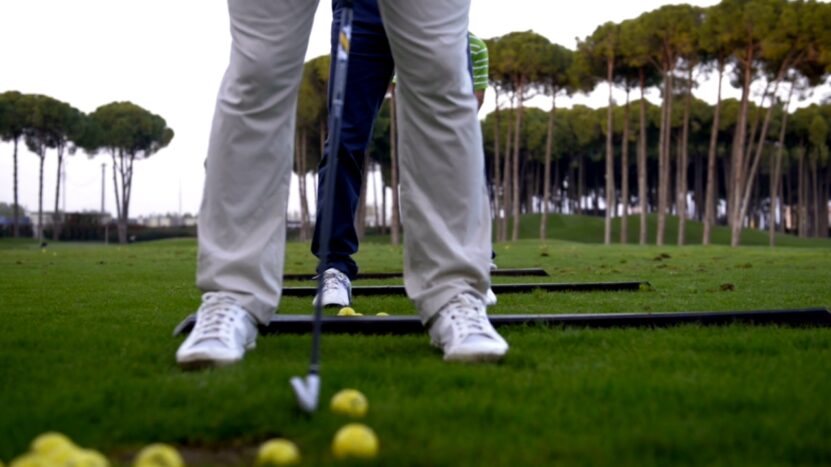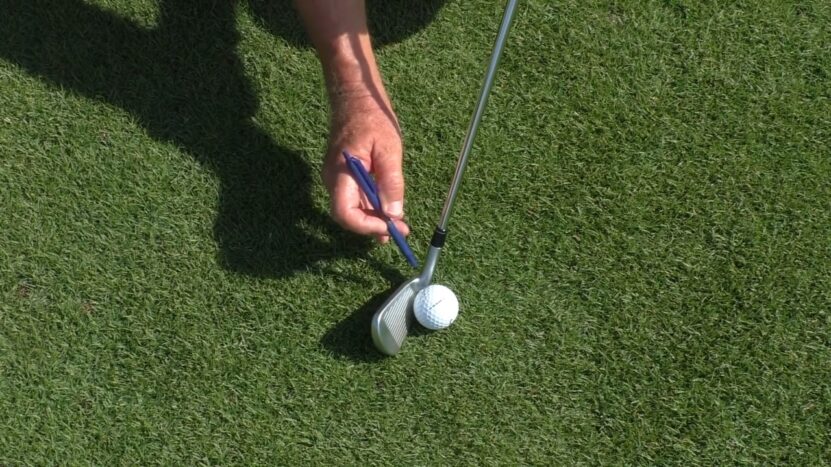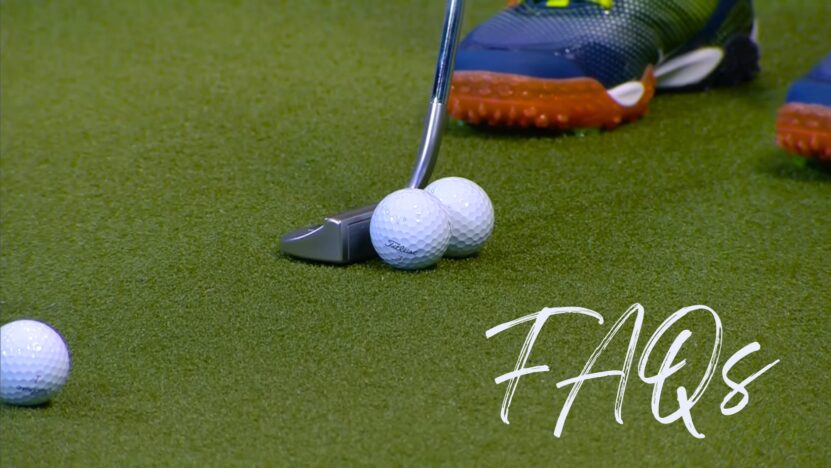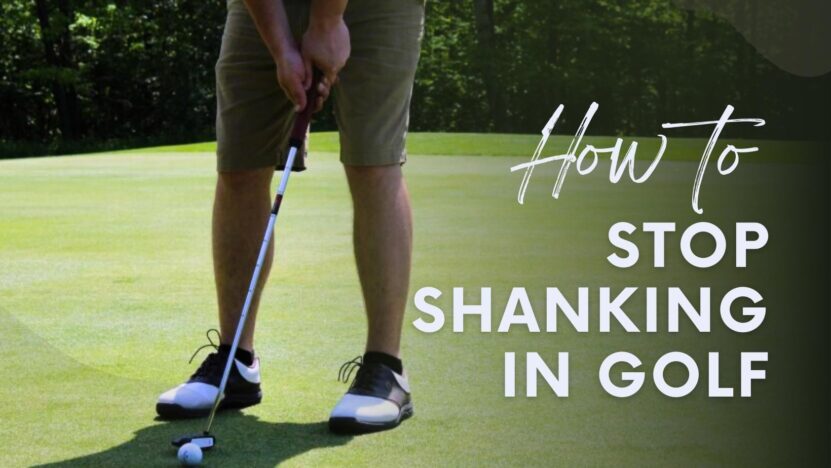The shank: it’s one of the most dreaded words in golf. Hitting a shank can be both embarrassing and demoralizing. It’s a shot that can throw even the most seasoned golfer off their game. But fear not! In this comprehensive guide, we’ll explore the root causes of shanking and provide you with valuable insights and actionable tips to prevent it from happening. Whether you’re a weekend warrior or a seasoned professional, this blog post has something for everyone.
Before diving into the reasons behind shanking, let’s first define the term. A shank occurs when a golfer makes contact with the ball using the hosel (the part of the club that connects the shaft to the clubface) instead of the clubface itself. The result is an unpredictable, often disastrous shot that can send the ball veering off course.
Poor Setup and Alignment

One of the main reasons golfers shank the ball is due to poor setup and alignment. When a golfer’s feet, hips, and shoulders aren’t aligned properly, it’s much more likely that they’ll make contact with the hosel.
To correct this, ensure that your feet are parallel to the target line and your shoulders are square to the target. Your hips should also be in line with your feet and shoulders. Take a few practice swings to make sure your body is properly aligned before addressing the ball.
Incorrect Weight Distribution
Another common cause of shanking is incorrect weight distribution during the swing. Golfers who shift their weight too far towards their toes or heels are more likely to make contact with the hosel. This is because the shift in weight can cause the clubface to move closer or farther away from the body, increasing the chance of a shank.
To correct this issue, focus on keeping your weight balanced and centered throughout your swing. As a general rule, your weight should be evenly distributed between your heels and toes during setup and should transfer to the inside of your back foot during the backswing. During the downswing, shift your weight towards your front foot, making sure not to lean too far forward or back.
Early Release or Casting
Casting or early release occurs when a golfer releases the club too early in the downswing, causing the clubhead to move outward and away from the body. This can result in the hosel making contact with the ball, leading to a shank. To fix this issue, focus on maintaining the angle between your wrists and the club shaft during the downswing. This will help keep the clubhead closer to your body and promote a more solid impact with the ball.
One helpful drill involves placing a tee about six inches behind the ball, on an extension of your target line. Practice making slow-motion swings, focusing on keeping the clubhead low to the ground and grazing the tee during your downswing. This will help you feel the proper release and encourage a more consistent impact position.
Overactive Hands and Arms
Another cause of shanking is an overreliance on the hands and arms during the swing. Golfers who try to generate power by flipping their wrists or using their arms to pull the club through impact are more likely to make contact with the hosel. Instead, focus on using your body rotation to generate power and maintain control over the club. As you start your downswing, engage your core and rotate your hips toward the target, allowing your arms to follow.
This will help keep the club head on the correct path and reduce the likelihood of a shank. To practice this, try the “step drill.” Begin with your feet together and the ball positioned in the middle. As you start your backswing, step forward with your front foot, planting it in its normal position. As you step, rotate your hips and allow your arms to follow. This drill encourages proper sequencing and helps to engage the body in the swing.
The impact of club selection

Shanking in golf can be caused by a variety of factors, including the club that a golfer is using. Certain clubs may be more difficult to control and can increase the likelihood of shanking. For example, some golfers may find that they shank more frequently when using long irons or wedges with a lot of lofts. To address the impact of club selection on shanking, golfers may want to consider using different clubs or adjusting their swing technique to compensate for the particular challenges posed by the club.
For example, golfers who struggle with shanking when using long irons may want to consider switching to hybrid clubs, which offer a larger clubface and more forgiving design. Golfers may also want to work on their swing technique to minimize the risk of shanking. This can include focusing on proper grip and posture, as well as developing a consistent swing tempo and rhythm. A golf coach or instructor can help golfers identify areas of their swing that may be contributing to shanking and provide guidance on how to make adjustments.
Swinging Too Hard or Fast
In their quest for distance, many golfers swing the club with excessive force. This can lead to a loss of control and balance, increasing the chances of a shank. The key to a successful swing is maintaining control and tempo while still generating power.
To improve your tempo and prevent shanking, try the “counting drill.” As you take your backswing, mentally count “one.” As you begin your downswing, count “two,” and as you make contact with the ball, count “three.” This will help you maintain a consistent tempo and promote better control throughout your swing.
The benefits of working with a golf coach
A good instructor can analyze your swing and help you correct your form. They can identify the specific mistakes you’re making that lead to shanking and provide you with drills and exercises to fix them. One of the biggest benefits of working with a coach is the feedback they can provide. They can give you immediate feedback on your swing and help you make adjustments on the spot. They can also video your swing so you can see your form and identify any problem areas.
Another benefit is the accountability a coach provides, having someone to answer to can help you stay on track with your goals and stay motivated to improve. Working with a coach can help you improve your overall game, not just eliminate shanking. A coach can help you develop a consistent swing, improve your accuracy, and increase your confidence in the course.
Mastering the Art of Correction
Now that we’ve identified the common causes of shanking, let’s explore some actionable tips and drills to help you eliminate this frustrating problem from your game.
The Basket Drill
The basket drill is an excellent way to address several of the issues that can lead to shanking. Place a range bucket or similar object about two feet outside your ball and slightly behind it. The goal is to make a full swing without hitting the bucket, which will encourage a more in-to-out swing path, proper weight transfer, and body rotation.
The Tee Drill
Another useful drill to help prevent shanking is the tee drill. Set up two tees, one for the ball and another an inch or two outside the ball. The goal is to make a swing that strikes the ball without hitting the outer tee. This will encourage a proper swing path and prevent the clubhead from moving too far outwards during the downswing.
The Two-Ball Drill
The two-ball drill is a great way to work on proper weight distribution and balance. Set up two balls, one in your normal hitting position and another directly behind it, about an inch away. Address the ball as you normally would, but focus on hitting the back ball without touching the front ball. This will force you to keep your weight centered throughout your swing and promote proper balance.
Addressing mental factors
A golfer may feel anxious or nervous while addressing the ball, leading to poor shot execution. Addressing these mental factors is a critical step in overcoming shanking. One effective method is to practice visualization techniques. Before taking a shot, a golfer can visualize a successful shot and focus on positive outcomes. Another approach is to practice deep breathing or meditation techniques, which can help calm nerves and reduce anxiety.
It’s also fundamental to have a consistent pre-shot routine that can help establish a mental rhythm and reduce anxiety. This routine can include visualizing the shot, taking deep breaths, and focusing on the target. It’s crucial to maintain a positive mindset during practice and competition. Golfers should avoid getting discouraged after a shank and instead focus on learning from their mistakes and making adjustments to their swing or mental approach.
FAQs

What is the goal of the two-ball drill?
The two-ball drill aims to improve weight distribution and balance during the golf swing. By setting up two balls and focusing on hitting the back ball without touching the front ball, you’re forced to keep your weight centered throughout your swing, promoting proper balance and reducing the likelihood of shanking.
How can I work on my swing tempo to prevent shanking?
You can improve your swing tempo by using the “counting drill.” Mentally count “one” during your backswing, “two” during your downswing, and “three” as you make contact with the ball. This will help you maintain a consistent tempo and promote better control throughout your swing, reducing the risk of shanking.
Can a poor grip cause shanking?
While a poor grip isn’t a direct cause of it, it can contribute to other issues that lead to shanking, such as an improper swing path or early release. Ensuring you have a proper grip on the club can help improve your overall swing mechanics and reduce the risk of shanking.
How often should I practice to prevent shanking?
The key to preventing it is consistent practice. Dedicate time to work on your swing fundamentals, focusing on proper alignment, weight distribution, and swing path. You should also incorporate specific drills like the basket drill, tee drill, and two-ball drill into your practice routine. The more you practice, the more you’ll ingrain proper swing mechanics, reducing the risk of shanking.
Can equipment issues contribute to shanking?
Yes, equipment issues can contribute to it. Using clubs that are too long or too short, have an incorrect lie angle, or have improperly fitted grips can negatively impact your swing mechanics, leading to a higher likelihood of it. It’s essential to have your clubs properly fitted by a professional to ensure they’re the right fit for your swing and body type.
Conclusion
Shanking is a frustrating and challenging issue that plagues golfers of all skill levels. However, by understanding the root causes of shanking and implementing the tips and drills outlined in this guide, you can effectively eliminate this dreaded shot from your game. Remember, the key to success is patience and consistent practice. Don’t get discouraged if you don’t see immediate results – even the best golfers experience setbacks. Keep working on your swing fundamentals, and soon, you’ll be shanking no more. Happy golfing!

